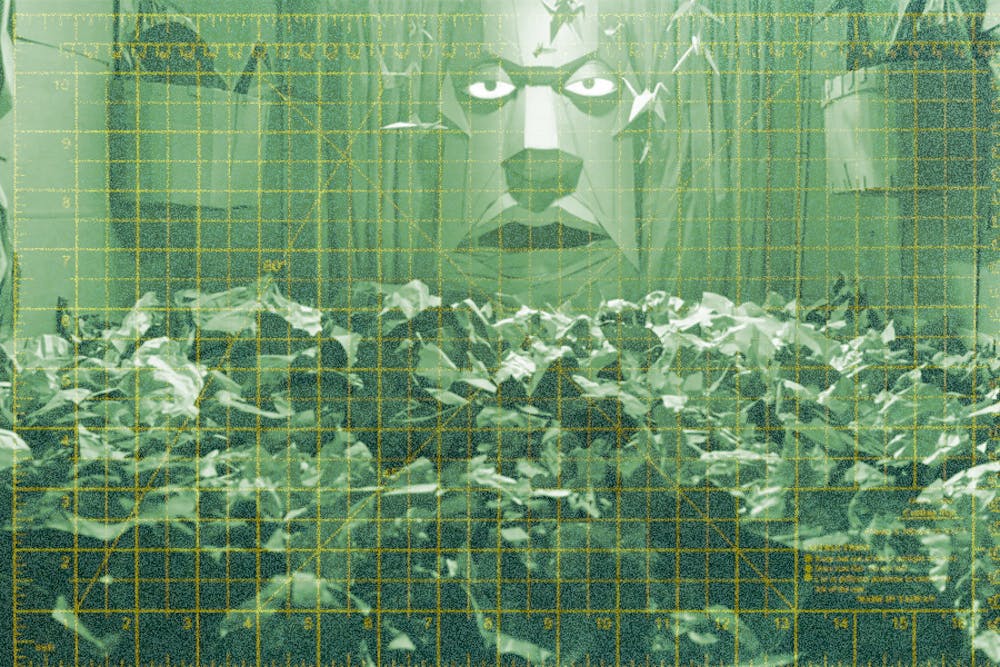An arts–and–crafts project may not seem like the scariest premise for a film, but make the medium a blood–thirsty cardboard monster complete with a vicious minotaur and an all–seeing paper vulva, and you get the most wonderfully absurd horror movie to exist. The 2017 picture Dave Made a Maze, directed by Bill Watterson, can't be constricted to a single genre. It combines fantasy, adventure, and horror with comedic and even romantic elements, creating the perfect choice for a Halloween movie night or just when you're craving something different.
In the first couple of minutes, the mockumentary–style presentation reveals itself as the titular character and unemployed artist Dave (Nick Thune) reflects on the primary conflict: His cardboard fort has evolved into a murderous trap. For those who have watched the movie, it's safe to say his craft project has gotten utterly "out of hand."
When his girlfriend, Annie (Meera Rohit Kumbhani), returns from a weekend trip, the danger unravels as she—along with his best friend, Gordon (Adam Busch) and a film crew led by aspiring director Harry (James Urbaniak)—venture into the fort. To their amazement, the box home is roomier inside. It's so large, in fact, that they quickly get lost inside a gallery of corrugated pathways, tunnels, and even booby traps. The rest of the movie follows Annie and the crew as they discover the fantastical world of the maze and the mystical dangers that roam it, all in their attempt to save Dave.
The plot itself is ridiculous, and the acting is nowhere near an Oscar consideration, yet it remains one of the most enjoyable movies over the last few years. Other than the sheer creativity and entertainment value of these one–of–a–kind concepts, behind the provocative humor and cartoons are sympathetic characters trying to make something beautiful in a mundane world. Through wildly impressive stop–motion and animated visuals that can only be compared to cartoons such as Coraline and Nightmare Before Christmas, Watterson invokes a sense of childlike wonder in the viewer.
At times, the characters are portrayed as immature and often unreasonable. Dave can be viewed as the archetype of a man–child, reliant on Annie to clean up his messes. However, as the story progresses, we understand him as a tragic example of a person trying to make something of himself, yet constantly failing. For Dave, this maze is a chance to see a project through, yet his self–doubt and anxieties manifest themselves in the monsters lurking in his work.
The film answers the classic question of “Why should we care about these characters?” through the interactions the characters have with each other. The team knows they can survive this maze because they have survived film projects, job searches, and the mediocrity of everyday life with each other. Their chemistry is likely because the characters were based on friends and coworkers of Watterson.
In a Sundance interview, Watterson states how most of the production team had worked with him through Stoopid Buddy Stoodios. He had the chance to work with the talented Trisha Gum, one of his several teammates and animators that was up to the design challenge of creating an entire set out of cardboard. The 80–minute film required 30,000 square feet of recycled cardboard that was repurposed after every scene. The endless cycle of disposable madness was, as Kumbhani describes it, “an adventure of a month” where the cast and crew entered into a surreal world every time they walked on set. The beauty of the film, as he recalls, came from “the sense of community, the sense of madness, [and] anarchy.”
The acting is reminiscent of a school project, but the whole movie leans into a very amateur, student–film style of cinematography. The film feels self–aware in this aspect, as the goofy characters are aspiring filmmakers themselves who try to fabricate serious, heartfelt scenes between yarn cannons and origami crane attacks.
In the horror genre, where directors often shove in jump scares and gruesome attacks for pure shock value rather than meaning, Dave Made a Maze serves as a refreshing example of not taking yourself too seriously and prioritizing creative freedom over an overused horror outline. While this may not be the film if you’re looking to be hiding in your popcorn bucket and jumping in terror, it promises to be a cinematic experience unlike anything you’ve seen before. In a world that prioritizes machine–like jobs and mindless productivity, sometimes thinking outside the cardboard box can create extraordinary results.







